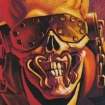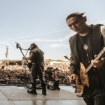Shop for Iron Maiden vinyl, collectibles and more at Revolver's store.
On March 22nd, 1982, Iron Maiden released The Number of the Beast — the album that forever changed the course of their lives and helped alter the trajectory of mainstream heavy metal and culture as we know it.
Sure, by that point founder/bassist Steve Harris and his scrappy East London crew had already made a name for themselves as a preeminent force in the burgeoning New Wave of British Heavy Metal scene thanks to their landmark 1980 self-titled debut and the following year's equally stellar Killers. Those powerful musical statements established the signature Maiden template: galloping bass-driven rhythms, soaring dual-guitar attack, adventurous arrangements, strong melodies and a storytelling lyrical approach that pulled from classic literature, history, films and more.
But The Number of the Beast was a gigantic leap forward for the band, both creatively and commercially. Iron Maiden refined their core elements on their third record, while embracing the progressive, theatrical style that would define their career and turn them into stadium-filling heavy-metal icons.
Central to that effort was the addition of new singer Bruce Dickinson, formerly of Samson, who was tapped to replace the sacked Paul Di'Anno. Dickinson's wider vocal range (and innate dramatic flair) enabled primary songwriter Harris and the rest of the band — guitarists Adrian Smith and Dave Murray, and drummer Clive Burr — to find a new gear and create an album for the ages.
From its opening call-to-arms "Invaders" and rousing "Prisoners" to side-two bangers "The Number of the Beast" and "Run to the Hills" to the epic seven-minute closer "Hallowed Be Thy Name," the album is a master class in NWOBHM. But its impact was felt far beyond that localized scene.
The Number of the Beast was a massive global hit for Maiden, reaching Number 1 on the U.K. Albums Chart and cracking the Top 40 charts in the U.S. The album's powerhouse title track also became an unexpected firebrand that incited widespread protests from religious and conservative groups because of its seemingly satanic lyrics and cover illustrator Derek Riggs' Eddie-as-devilish-puppet master artwork. The hate only helped get the message out to the true metal believers (plus a ton of potential converts) that this album was not to be missed.
Since its release, The Number of the Beast's legacy has grown to mythic proportions. It's sold nearly 20 million copies worldwide, and critics and fans consistently rank it among the best metal albums of all time. Below, we present 10 things you may not know about Iron Maiden's breakout record.
1. "The Number of the Beast" was inspired by Steve Harris' love of horror films ... and Scottish poetry
Since the band's 1975 inception, main songwriter Steve Harris has found lyrical inspiration in a mix of highbrow and popular sources: from classic literature and historical texts to television shows and movies. Such was the case for The Number of the Beast's diabolical title track, which pulls from a witchy 18th century Scottish poem by Robert Burns and a dream Harris had after watching the 1978 horror film Damien: Omen II.
"It was things like watching The Omen but it was more inspired by a poem called 'Tam o' Shanter,' Harris told Rolling Stone in 2019. "I've just always liked reading books and watching horror films."
Harris' horror-meets-poetry source material might seem innocuous now, but The Number of the Beast arrived at the dawn of the Eighties "satanic panic" fervor during which conservative groups and media outlets embraced a conspiracy theory that devil-worshipping cults had infiltrated society and — with the help of more than a few pop, rock and metal acts — were corrupting the moral fiber of America's youth. Upon its release, religious organizations and petrified parents widely protested the album; some went so far as to organize public burnings of The Number of the Beast records. The outrage came as a shock to Harris and Company.
"The negative reactions to 'The Number of the Beast' were strange," Harris told told Revolver in 2007. "When we wrote it, we never expected anything like that. It was funny at first — we thought everyone was just being crazy. But then we realized people were serious about it, and we were like, 'Oh, dear…' [Laughs]"
"It was mad," Harris continued about the public's reception in Mick Wall's Iron Maiden: Run to the Hills, the Authorised Biography. "They completely got the wrong end of the stick. They obviously hadn't read the lyrics. They just wanted to believe all that rubbish about us being Satanists."
2. Horror film legend Vincent Price turned down a guest appearance on "The Number of the Beast"
"The Number of the Beast" starts with an evocative spoken-word section cribbed from the Bible's Revelation 12:12 and 13:18: "Woe to you, oh earth and sea/For the Devil sends the beast with wrath/Because he knows the time is short/Let him who hath understanding reckon the number of the beast/For it is a human number/ Its number is six hundred and sixty-six."
In 2017, Dickinson confirmed to Eddie Truck on Sirius XM that the band initially approached iconic horror actor Vincent Price to deliver the chilling lines. Except, "Mr. Price doesn't get out of bed for less than $10,000," the singer recounted with a laugh. At the time, Maiden didn't have the budget, so they enlisted English actor Barry Clayton "who used to read the ghost story on the radio station in London," because "he sounds kinda like Vincent Price … and was like 300 bucks."
3. Producer Martin Birch received a "satanic" bill while making The Number of the Beast
Iron Maiden may not have been Satanists, but that didn't stop some spooky coincidences from occurring while making The Number of the Beast. During the album's sessions, producer Martin Birch got into a car accident and his vehicle had to go into the shop for repairs. Everything was business as usual — until Birch received the mysteriously diabolical bill totaling £666.
Harris recounted the story to Metal Hammer in 2015: "One weird thing that happened was that Martin went to get his car repaired after it had been in an accident, and the bill came to £666. He was so freaked out that he insisted the garage charged him £667. It must have been the first time that garage had ever come across someone who demanded to pay more."
4. Bruce Dickinson's prior Samson contract prevented him from receiving songwriting credits on The Number of the Beast
Bruce Dickinson's fundamental involvement in The Number of the Beast is, well, self-evident. His increased vocal range and theatrical style opened a whole new world of storytelling and songwriting possibilities for Steve Harris.
"It was fate that Bruce came in," Harris told us. "He was so fantastic, and he could hit notes and do things most other singers couldn't. But at the time, it was pretty scary! [Laughs] We were already headlining most countries, and it was scary changing a singer because we didn't know if people were gonna like it or not. The Number of the Beast was a lot of pressure, but sometimes, pressure brings out the best in you. And it did. It paid off big time."
"I simply didn't think [former singer Paul Di'Anno] was capable of handling lead vocals on some of the quite complicated directions I knew Steve wanted to explore," producer Martin Birch told Mick Wall in Run to the Hills. "When Bruce joined, it opened up the possibilities for the new album tremendously."
Despite his central role in the creation of the album, because of contractual issues with his previous band Samson, the singer was not allowed to receive any songwriting credits.
Back in 1996, Dickinson confirmed that while "legal reasons" prevented him from getting credit, he "had a very big moral contribution to certain songs. Like 'Children of the Damned,' 'Run to the Hills' and 'The Prisoner.' Those three songs were the songs in which I had the biggest moral contribution."
5. Steve Harris thought "Invaders" should have been replaced
The Number of the Beast's leadoff track, "Invaders," is a riff-heavy affair that sets the galloping pace for the record with its ascending/descending guitar lines, mid-song solo excursions and cinematic storytelling. But, in retrospect, Harris didn't think it stood up to the rest of the album's material.
"'Invaders' … could have been replaced with something a bit better, only we didn't have anything else to replace it with at the time," Harris recounted to Mick Wall in Run to the Hills. "We had just enough time to do what we did, and that was it."
"I don't think it's one of my strongest songs, really," Harris said on the Eddie Trunk Podcast. "I think it's alright, it's not a bad song, but it doesn't stand out to the rest of the album."
"When you're making the album at the time, you don't really think if one's better than the others, you get a genuine feeling. I also thought that 'Gangland' was supposed to be a B-side or a single and 'Total Eclipse' should've been on the album."
6. "Children of the Damned" was inspired by a classic British horror movie ... and Dio-era Black Sabbath
Like The Number of the Beast's title track, Harris drew from another classic horror film, 1964's Children of the Damned, for the Maiden song of the same name.
"It was kind of based on the movie, I suppose. Loosely," Harris said of "Children of the Damned" in the 2001 documentary Classic Albums: Iron Maiden — The Number of the Beast. "Like most of our things were loosely based on anything. We just take the basic idea and then develop it from there really, and try to put our own little twists and turns into it."
While Dickinson maintains he only offered a "moral contribution" to the writing of "Children of the Damned," in a 2010 episode of his BBC Radio show the singer revealed that the song was also influenced by Ronnie James Dio and Black Sabbath's 1980 jam "Children of the Sea."
7. "Run to the Hills" has roots in the work of American Western novelist Louis L'Amour
As mentioned, Harris regularly found ripe source material in films. The musician also discovered a wealth of storytelling ideas from historical literature and fiction. Such is the case with The Number of the Beast's hit single "Run to the Hills," which examines the violent colonization of America from the perspectives of both the North American indigenous people and American cavalrymen.
"This song is about the American Indians," Harris told John Stix in 1983. "It's written from both sides of the picture. The first part is from the side of the Indians. The second part is from the side of the soldiers. I wanted to try and get the feeling of galloping horses. But when you play this one, be careful not to let it run away with you."
"We've always been fascinated with Western movies and books," Harris reiterated in a 2019 Rolling Stone interview. "I was interested in a lot of things but I had never been to America at that point. I just used to read a lot of books by an author called Louis L'Amour and I got inspired. The first few lines of ["Run to the Hills"] were definitely inspired by reading those types of books."
8. "The Prisoner" was inspired by a British TV show of the same name
The Prisoner was a popular British science fiction television show from 1967, which provided the inspiration for The Number of the Beast's third track. Harris and co-writer Adrian Smith even bit a portion of the groundbreaking show's title sequence dialog for the song's intro.
"We want information…information…information!"
"Who are you?"
"The new Number Two."
"Who is Number One?"
"You are Number Six."
"I am not a number! I am a free man."
Mick Wall wrote in his Iron Maiden biography that the band's longtime manager Rod Smallwood was tasked with reaching out to The Prisoner's "real bona fide superstar actor" Patrick McGoohan to ask permission to use the audio clips. It's reported that McGoohan's response was "What did you say the name was? A rock band, you say? Do it."
9. During The Number of the Beast tour, Iron Maiden were low on funds … and high on drugs
The Number of the Beast may have gone on to become Maiden's best-selling album, but during the months of touring after its release the band weren't exactly flush with cash. "I don't think any of us has a credit card between us," Dickinson wrote of that time period in his 2017 autobiography What Does This Button Do? But, of course, that didn't stop some of the guys from partying like rock stars.
"The biggest factor that changes 'Saturday night out with the lads in a band' to 'every Saturday spent in rehab or therapy' is money and drugs," Dickinson wrote of Maiden's debauched state during The Number of the Beast tour. "Everyone wanted to give us drugs, lots of them, and all for free."
10. Bruce Dickinson and Steve Harris nearly came to blows during Maiden's 1982 world tour
Money worries and drug distractions weren't the only friction points during the world tour in support of The Number of the Beast. It was Dickinson's first extended trek with the band, and he recounted in his autobiography that he and Harris repeatedly clashed over onstage etiquette — highly charged interactions that very nearly resulted in punches being thrown.
"When I was singing, half a bass guitar was being stuck up my nose, because clearly there was some demarcation zone I had infringed," he wrote. "I countered by putting ludicrously long legs on my mic stand ... in my peripheral vision, I could see Steve careening towards me, so I positioned it as a sort of anti-bass-player tank trap."
It all came to a head after Iron Maiden's show in Newcastle, England. "We went on stage, quite a small stage, and Steve and I spent a bad-tempered evening like two rutting stags locking antlers," Dickinson wrote. "Rod [Smallwood] needed to separate us backstage. We were both busy rolling up our sleeves to go outside and sort each other out. Steve was yelling at Rod as he separated us, 'He's got to fucking go!'"
But Dickinson didn't split; instead, he and Harris worked out a compromise, concluding that, "in the case of who stands in front of whom, good manners trumps boundless enthusiasm."












